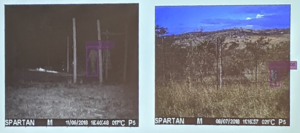
Can Artificial Intelligence Help Pinch Poachers?

From elephants and rhinos to sea turtles and lemurs, poaching is quickly driving many endangered species to the brink of extinction. Often, governments and activists struggle to effectively monitor vast expanses of land for handfuls of poachers who travel at night. So what if artificial intelligence did it for them?
In South Africa, conservationists were making no headway on preventing rampant rhino poaching. Hluhluwe–iMfolozi Park, the “birthplace of rhinos,” was a particular hotspot, logging hundreds of dead rhinos in a single year. So Peace Parks Foundation, a conservation nonprofit, set its sights on improving the situation in the park with the help of AI researchers from Microsoft.
“The exponential increase in rhino poaching in South Africa has radically transformed the conservation environment,” said the CEO of Peace Parks Foundation, Werner Myburgh. “Rangers and conservation agencies are scrambling to respond in a timely manner on already stretched resources.”
The Foundation and Microsoft set to work in May 2018. The goal was to use an integrated, high-tech approach to identify poachers through camera imagery.
There were a number of challenges. The dataset was large and imbalanced, with tens of thousands of images – the vast majority absent any relevant people, vehicles or animals. They had to work in both color and grayscale, for night vision. The resolution was low and distorted. The developers also had to work within tight constraints: the system had to work quickly, and false negatives were more or less unacceptable, but too many false positives would render the system useless when allocating limited resources.

An example of the AI poacher detection in action. Image courtesy of Olga Liakhovich and Gabriel Domínguez Conde.
The developers settled on RetinaNet, an object identification model developed by Facebook AI Research (FAIR), which they found satisfied the necessary performance and inference time requirements. By March 2019, they had deployed their new, cutting-edge anti-poaching technology infrastructure in the park. Remote cameras placed at poaching hotspots began feeding tens of thousands of images to a central “nerve center” within the park. From there, the images were scanned by Microsoft Azure-based artificial intelligence. If a potential poacher was identified by the AI, an alert was sent to park rangers.
“Within a period of just over three months, more than 25,000 images were received by in-field cameras,” said Doug Gillings, programme manager at Peace Parks Foundation. “Using Azure’s AI scanning capabilities, the system was able to return less than 1,300 images that were relevant in terms of potential human incursion, preventing the team from being overwhelmed by an influx of data.”
The researchers don’t plan to stop there. Current plans involve collecting more data from more camera traps, adding sound sensors (for gunshots) and thermal cameras, using on-device model inference and improving patrol routes.
“I think the main takeaway for us is to celebrate that technology is now at the point where each and every one of us can do impactful projects and make a real difference,” said Olga Liakhovich, principal data and applied scientist at Microsoft, at KDD 2019. “We have not done any super sophisticated things in here; we use the state-of-the-art models that are published by the community and open source, and feed the data into them to see what goes best. So just go ahead and do this.”



























